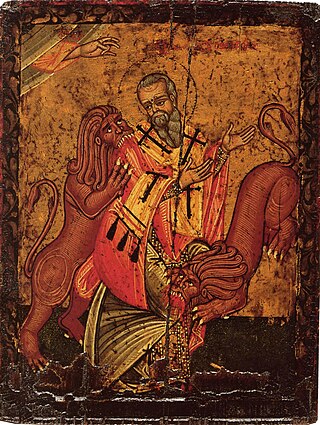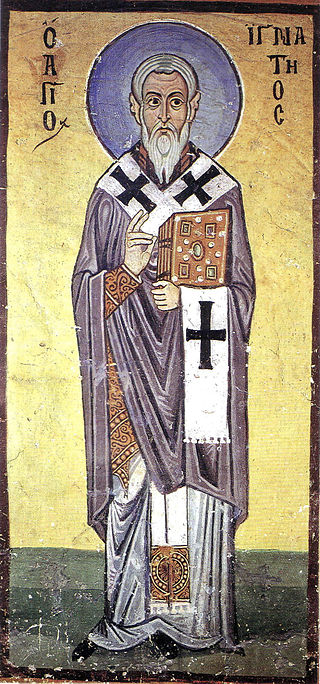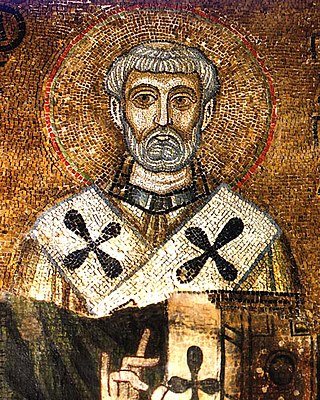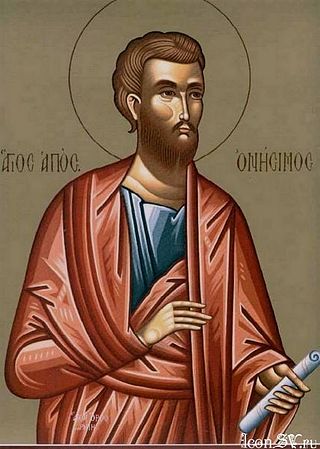
The word catholic comes from the Greek phrase καθόλου 'on the whole, according to the whole, in general', and is a combination of the Greek words κατά 'about' and ὅλος 'whole'. The first known use of "Catholic" was by the church father Saint Ignatius of Antioch in his Letter to the Smyrnaeans. In the context of Christian ecclesiology, it has a rich history and several usages.

The Epistle to the Philippians is a Pauline epistle of the New Testament of the Christian Bible. The epistle is attributed to Paul the Apostle and Timothy is named with him as co-author or co-sender. The letter is addressed to the Christian church in Philippi. Paul, Timothy, Silas first visited Philippi in Greece (Macedonia) during Paul's second missionary journey from Antioch, which occurred between approximately 50 and 52 AD. In the account of his visit in the Acts of the Apostles, Paul and Silas are accused of "disturbing the city".

Ignatius of Antioch, also known as Ignatius Theophorus, was an early Christian writer and Patriarch of Antioch. While en route to Rome, where he met his martyrdom, Ignatius wrote a series of letters. This correspondence forms a central part of a later collection of works by the Apostolic Fathers. He is considered one of the three most important of these, together with Clement of Rome and Polycarp. His letters also serve as an example of early Christian theology, and address important topics including ecclesiology, the sacraments, and the role of bishops.

Polycarp was a Christian bishop of Smyrna. According to the Martyrdom of Polycarp, he died a martyr, bound and burned at the stake, then stabbed when the fire failed to consume his body. Polycarp is regarded as a saint and Church Father in the Eastern Orthodox Church, Roman Catholic Church, Oriental Orthodox Churches, Lutheranism, and Anglicanism.

Clement of Rome, also known as Pope Clement I, was the bishop of Rome in the late first century AD. He is considered to be the first of the Apostolic Fathers of the Church, and a leading member of the Church in Rome in the late 1st century.

Onesimus, also called Onesimus of Byzantium and The Holy Apostle Onesimus in the Eastern Orthodox Church, was a slave to Philemon, a man of Christian faith. He may also be the same Onesimus named by Ignatius of Antioch as bishop in Ephesus which would put Onesimus's death closer to 107. If so, Onesimus went from slave to brother to bishop.

An epistle is a writing directed or sent to a person or group of people, usually an elegant and formal didactic letter. The epistle genre of letter-writing was common in ancient Egypt as part of the scribal-school writing curriculum. The letters in the New Testament from Apostles to Christians are usually referred to as epistles. Those traditionally attributed to Paul are known as Pauline epistles and the others as catholic epistles.
The Apostolic Fathers, also known as the Ante-Nicene Fathers, were core Christian theologians among the Church Fathers who lived in the 1st and 2nd centuries AD who are believed to have personally known some of the Twelve Apostles or to have been significantly influenced by them. Their writings, though widely circulated in early Christianity, were not included in the canon of the New Testament. Many of the writings derive from the same time period and geographical location as other works of early Christian literature which came to be part of the New Testament.

The pastoral epistles are a group of three books of the canonical New Testament: the First Epistle to Timothy, the Second Epistle to Timothy, and the Epistle to Titus. They are presented as letters from Paul the Apostle to Timothy and to Titus. However, many scholars believe they were written after Paul's death. They are generally discussed as a group and are given the title pastoral because they are addressed to individuals with pastoral oversight of churches and discuss issues of Christian living, doctrine and leadership. The term "pastorals" was popularized in 1703 by D. N. Berdot and in 1726 by Paul Anton. Alternate nomenclature for the cluster of three letters has been proposed: "Corpus Pastorale," meant to highlight the intentional forgery of the letters as a three-part corpus, and "Letters to Timothy and Titus," meant to emphasize the individuality of the letters.

The Pauline epistles are the thirteen books in the New Testament traditionally attributed to Paul the Apostle.

The First Epistle to Timothy is one of three letters in the New Testament of the Bible often grouped together as the pastoral epistles, along with Second Timothy and Titus. The letter, traditionally attributed to the Apostle Paul, consists mainly of counsels to his younger colleague and delegate Timothy regarding his ministry in Ephesus (1:3). These counsels include instructions on the organization of the Church and the responsibilities resting on certain groups of leaders therein as well as exhortations to faithfulness in maintaining the truth amid surrounding errors.
Martyrdom of Polycarp is a manuscript written in the form of a letter that relates the religious martyrdom of Polycarp, Bishop of Smyrna in the 2nd century AD. It forms the earliest account of Christian martyrdom outside of the New Testament. The author of Martyrdom of Polycarp is unknown, but it has been attributed to members of the group of early Christian theologians known as the Church Fathers. The letter, sent from the church in Smyrna to another church in Asia Minor at Philomelium, is partly written from the point of view of an eye-witness, recounting the arrest of the elderly Polycarp, the Romans' attempt to execute him by fire, and subsequent miraculous events.

The Epistle of Polycarp to the Philippians is an epistle attributed to Polycarp, an early bishop of Smyrna, and addressed to the early Christian church in Philippi. It is widely believed to be a composite of material written at two different times, in the first half of the second century. The epistle is described by Irenaeus as follows:

The Epistle of Ignatius to the Trallians is an epistle attributed to Ignatius, a second-century Bishop of Antioch and martyr, and addressed to the church in Tralles. It was written during the bishop's transport from Antioch to his execution in Rome.

The Epistle of Ignatius to the Smyrnaeans is an epistle from circa 110 A.D. attributed to Ignatius of Antioch, a second-century bishop of Antioch, addressed to the Early Christians in Smyrna.

The Epistle of Ignatius to the Romans is an epistle attributed to Ignatius of Antioch, a second-century bishop of Antioch. It was written during his transport from Antioch to his execution in Rome. To the Romans contains Ignatius’ most detailed explanation of his views on martyrdom.
The Martyrdom of Pionius is an account dating from about 250 AD to 300 AD of the martyrdom of a Christian from Smyrna named Pionius. It is also known as The Martyrdom of Pionius the Presbyter and His Companions, The Acts of Pionius, and in Latin as Martyrium Pionii or Passio Pionii. Pionius was a presbyter, and was most likely killed between 249 and 251 AD during the rule of the Roman Emperor Decius. The feast day of Saint Pionius is kept on March 11 in Eastern Orthodox churches, and on February 1 in Roman Catholicism.

The Epistle of Ignatius to the Magnesians is an epistle attributed to Ignatius of Antioch, a second-century bishop of Antioch, and addressed to the church in Magnesia on the Maeander. It claims to have been written during Ignatius' transport from Antioch to his execution in Rome.

The Epistle of Ignatius to the Philadelphians is an epistle attributed to Ignatius of Antioch, a second-century bishop of Antioch, and addressed to the church in Philadelphia of Asia Minor. It was written during Ignatius' transport from Antioch to his execution in Rome.

The Epistle of Ignatius to the Ephesians is an epistle attributed to Ignatius of Antioch, a second-century bishop of Antioch, and addressed to the church in Ephesus of Asia Minor. It was written during Ignatius' transport from Antioch to his execution in Rome.









